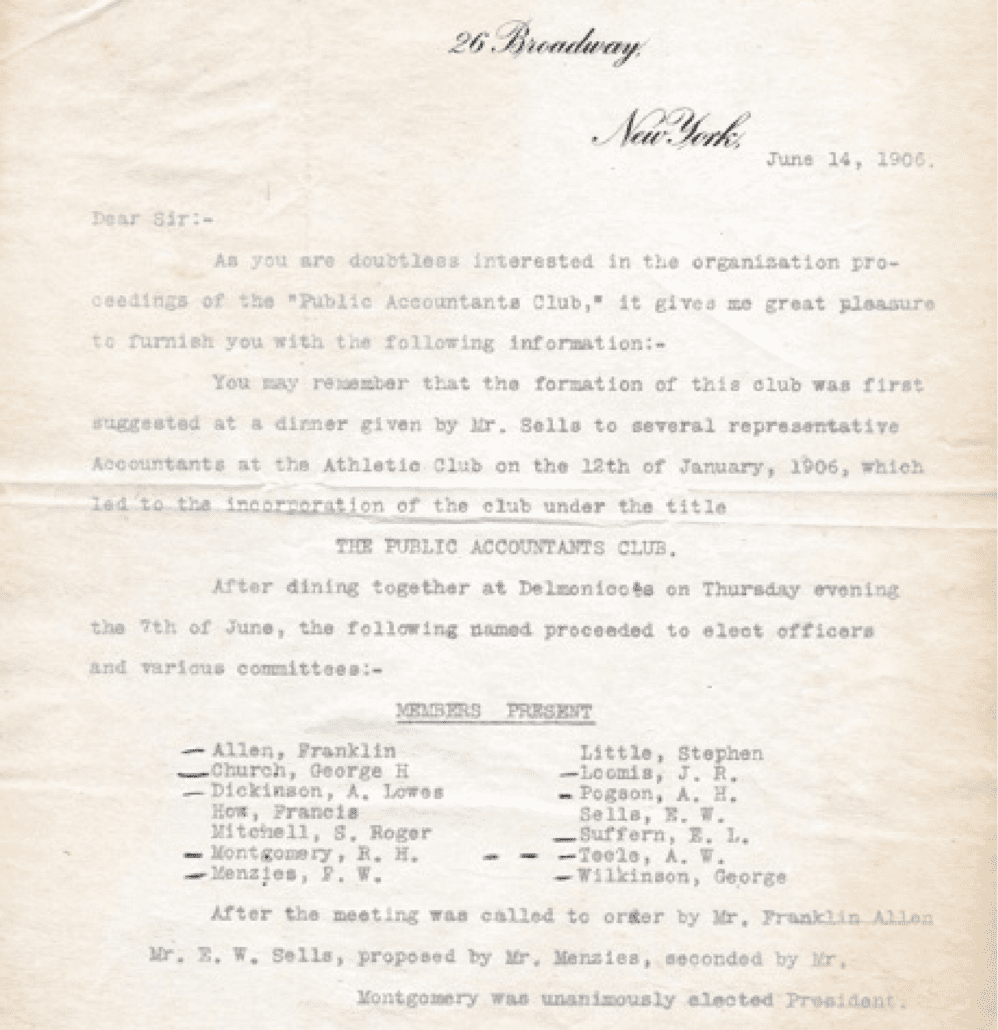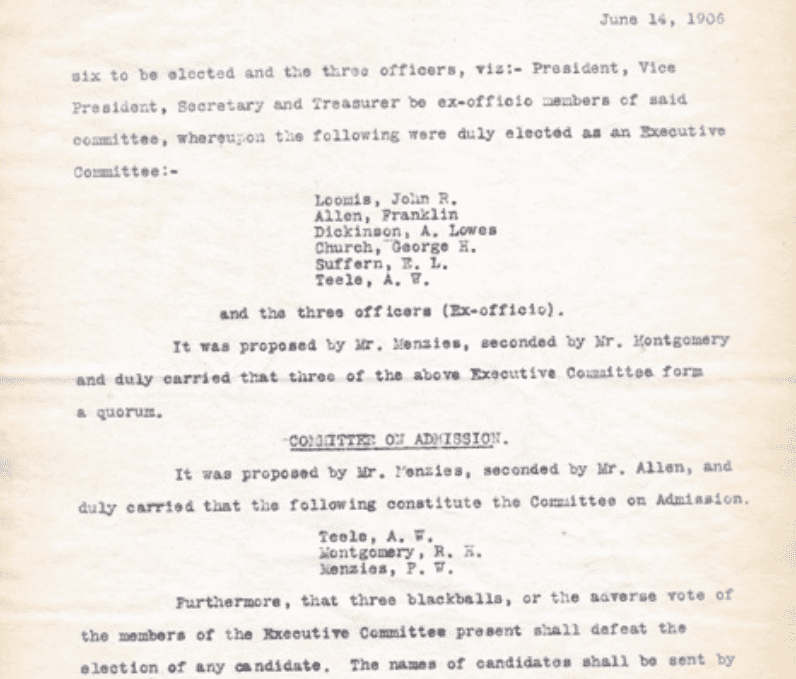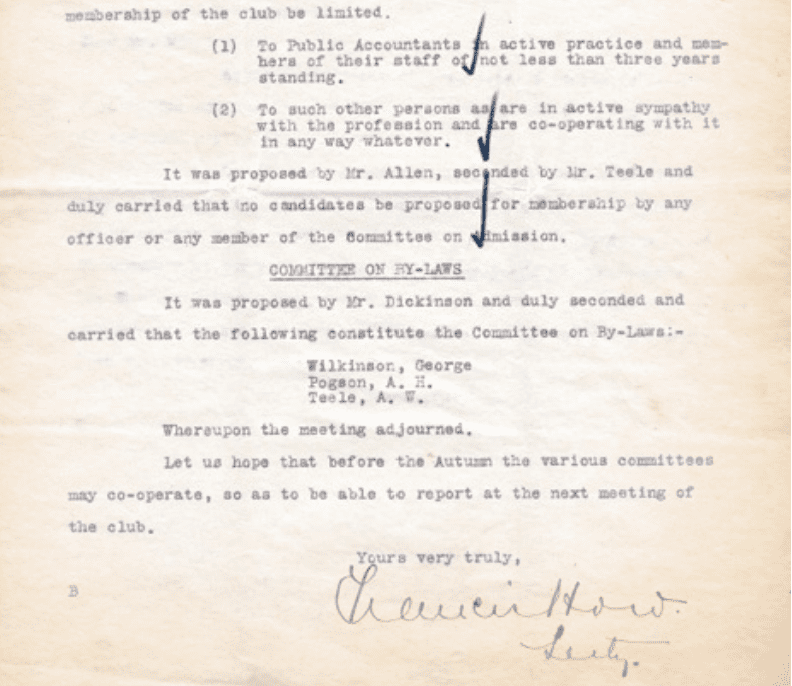Accountants Club of America History
Looking Back
An Accountants Club has been a part of American professional accountancy for over a century. It had its origin in the mind, of Elijah Watts Sells who, with his friend, Charles Waldo Haskins, founded the firm that bears their name. It’s important that we know about the Accountants Club of America History.
Soon after the incorporation of the New York State Society of Certified Public Accountants (NYSSCPA), of which Mr. Haskins was the first president, Mr. Sells began urging the Society to make a place in its program for sociable and non-professional meetings of the members. It was his firm conviction that if the members were to meet in friendly comradeship they would be bound together more closely for the advancement of professional ideals.
As outlined in letters dated June 14, 1906 and August 07, 1906 Francis How, as Treasurer and Secretary, summarized the formation and incorporation of the “Public Accountants Club” with Elijah Watts Sells elected as its first President. The duration and termination of this club is unknown.
During the first dozen or fifteen years of the life of the NYSSCPA, its monthly meetings, held in a small room of the old Waldorf-Astoria Hotel, served reasonably well in building up personal friendships among the then limited number of its members. Time came, however, when larger attendance at the monthly meetings called for a more formal type of program, and incidentally for a limitation of opportunity for personal conversational contracts.
A group of men who shared Mr. Sells thoughts on the needs for informal gatherings of professional accountants, decided to put his ideas to a practical test. Several luncheon meetings were held in the McAlpin Hotel attended by James F. Hughes, Joseph J. Klein, Homer S. Pace, Phillip J. Warner and Willis S. Whittlesey. They were asked to make commitments to join and support an Accountants Club if one were organized. There was an encouraging response and shortly a number of other leading accountants also promised to do so on an “if and when” basis. However, it was 1917 and we became involved in the World War so the plan had to be laid aside.
Earlier attempts to form social groups had limited and short-term success. One was “The Hoot Club” which was formed by a small group of businessmen for purely social purposes. The origin of the name is obscure, probably purposely so. The accountant members of the group appear to have been able to find in that club’s light-hearted activities relief from what is frequently thought of as a very demanding occupation. On a more formal scale, a somewhat larger group formed “The Accountants Round Table.” It had a pleasant existence from about 1912 until 1917, being abandoned after the United States entered the World War.
Interest in the Club was not renewed fully until 1927, the year the partners of Haskins & Sells set up a foundation for the Club. It was at that time that the foundation group reminded those who had committed themselves to form The Accountants Club of their obligation to do so. At a private dinner party at the Waldorf-Astoria, given by Robert H. Montgomery and Arthur Carter, it was decided to proceed with the organization.
James P. Wynn of Colonel Montgomery’s office prepared organization papers. As plans matured, the decision was made to give the Club a national standing by including in its name the words “of America.” The following twenty-five incorporators met in Colonel Montgomery’s office on May 6th and signed the certificate of incorporation (see right).
“…if the members were to meet in friendly comradeship they would be bound together more closely for the advancement of professional ideals.”
The following twenty-five incorporators met in Colonel Montgomery’s office on May 6th and signed the certificate of incorporation:
David Berdon
Arthur H. Carter
Frederick G. Colley
Robert F. Connelly
William O. Cutter
Frank G. DuBois
Cecil D. Giles
Charles Hecht
Charles A. Heiss
Henry A. Horne
James F. Hughes
Orrin R. Judd
Daniel S. Young
Joseph J. Klein
Martin Kortjohn
Samuel D. Leidesdorf
John T. Madden
Henry E. Mendes
Perley Morse
Robert H. Montgomery
Homer S. Pace
James L. Ridgway
Frederick M. Schaeberle
Andrew Stewart
Phillip J. Warner
The certification was filed at Albany five days later and the Club acquired corporate existence. At the first meeting of the incorporators they became the first Board of Governors and proceeded to elect Robert Montgomery the first President and Samuel D. Leidesdorf as first Treasurer. A committee found quarters for the New Club in the Hotel Belmont that then occupied the southwest corner of Park Avenue and Forty-Second Street, just across from Grand Central. A dining room and some assembly rooms, all serviced by the hotel, formed the first home of the club. The detailed administration of the clubroom was in the hands of Major John M. Corson, a retired Army officer who had the title of House Secretary.
Membership in the Club was extended to all professional public accountants (certified public accountants and chartered accountants), to the members of the National Association of Cost Accountants, to other men of good character and of executive standing who had a vital interest in accountancy, such as bankers, credit men and many industrial accounting officials. A large membership was built up, divided into two classifications, Resident and Non-resident.
Before long, more spacious meeting-rooms were desired. In the then new Hotel Montclair at Lexington Avenue and Forty-ninth Street, a duplex apartment was rented and attractive furnishings were installed. Dining-rooms, social rooms, an out-door sundeck and, on the upper floor of the pent-house, an out-of-doors exercising area, were provided. Attendants were employed for dining-room and other services.
Each month the Board of governors met for dinner and for the administration of the affairs of the Club. There were also many matters of sentimental appeal in the friendly relationships of members in the club and in its Board of Governors. Among the unwritten rules of the Board was the agreement that one of the Governors was to be on duty in attendance at the Club every evening to welcome newcomers not familiar with the club-house, and especially to greet non-resident members.
Colonel Montgomery set a precedent with his initial years of service as President. Four of his successors served for five or more years. Since 1961, the term of president has been limited to two years.
After four years, Arthur H. Carter was chosen to succeed Robert H. Montgomery. The board of governors met at dinner and presented “Colonel Bob”, as he was called, a large silver tray, suitably inscribed, as a token of their esteem.
The luncheon meetings have been the persistently continuing feature of the Club’s life, but that has been supplemented throughout the years by dinner meetings. Those meetings have been both serious and fun. Guest speakers have included prominent economists, noted journalists, political scientists, authors, bankers and businessmen as well as our own members.
The vision of Elijah Watt Sells and his co-founders – of the need for a group of friendly professional men and women working together in both state and national societies for high standards of integrity and competency in the important area of financial accountancy – is as valid today as it was when Mr. Sells was living. The Accountants Club of America will continue to do its part in promoting that spirit of friendly comradeship among members of the profession.
“…and now having glimpsed the past, it is in order to look ahead to a more interesting future.”





